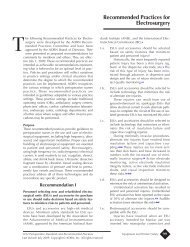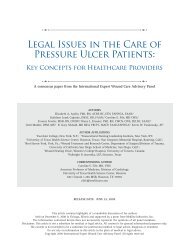15. Jain P, Parada JP, David A, Smith LG. Overuse of the indwelling urinary tract catheter in hospitalized medical patients. Arch Intern Med. 1995;155(13):1425-1429.16. Saint S, Wiese J, Amory JK, et al. Are physicians aware of which of their patients have indwelling urinary catheters? Am J Med. 2000;109(6):476-480.17. Edwards JR, Peterson KD, Andrus ML, et al. National healthcare safety network (NHSN) report, data summary <strong>for</strong> 2006, issued june 2007. Am J Infect <strong>Control</strong>.2007;35(5):290-301.18. Rogers MA, Mody L, Kaufman SR, Fries BE, McMahon LF,Jr, Saint S. Use of urinary collection devices in skilled nursing facilities in five states. J Am GeriatrSoc. 2008;56(5):854-861.19. Klevens RM, Edwards JR, Richards CL,Jr, et al. Estimating health care-associated infections <strong>and</strong> deaths in U.S. hospitals, 2002. Public Health Rep.2007;122(2):160-166.20. Weinstein MP, Towns ML, Quartey SM, et al. The clinical significance of positive blood cultures in the 1990s: A prospective comprehensive evaluation of themicrobiology, epidemiology, <strong>and</strong> outcome of bacteremia <strong>and</strong> fungemia in adults. Clin Infect Dis. 1997;24(4):584-602.21. Muder RR, Brennen C, Wagener MM, Goetz AM. Bacteremia in a long-term-care facility: A five-year prospective study of 163 consecutive episodes. Clin InfectDis. 1992;14(3):647-654.22. Umscheid C, Mitchell M, Agarwal R, Williams K, Brennan P. Mortality from reasonably-preventable hospital acquired infections. included in written testimony bythe society of healthcare epidemiology of america <strong>for</strong> the committee on oversight <strong>and</strong> government re<strong>for</strong>m hearing on healthcare-associated infections: Apreventable epidemic, chaired by henry A. waxman, april 16, 2008, washington, DC. [congressional testimony]. .23. Kunin CM, McCormack RC. <strong>Prevention</strong> of catheter-induced urinary-tract infections by sterile closed drainage. N Engl J Med. 1966;274(21):1155-1161.24. Tambyah PA, Halvorson KT, Maki DG. A prospective study of pathogenesis of catheter-associated urinary tract infections. Mayo Clin Proc. 1999;74(2):131-136.25. Garibaldi RA, Mooney BR, Epstein BJ, Britt MR. An evaluation of daily bacteriologic monitoring to identify preventable episodes of catheter-associated urinarytract infection. Infect <strong>Control</strong>. 1982;3(6):466-470.26. Saint S, Lipsky BA, Goold SD. Indwelling urinary catheters: A one-point restraint? Ann Intern Med. 2002;137(2):125-127.27. Warren JW, Tenney JH, Hoopes JM, Muncie HL, Anthony WC. A prospective microbiologic study of bacteriuria in patients with chronic indwelling urethralcatheters. J Infect Dis. 1982;146(6):719-723.28. Saint S, Chenoweth CE. Biofilms <strong>and</strong> catheter-associated urinary tract infections. Infect Dis Clin North Am. 2003;17(2):411-432.50
29. Kallen AJ, Hidron AI, Edwards JR, Patel J, Srinivasan A. Antibiotic resistance among important gram-negative pathogens causing healthcare-associatedinfections reported to the national healthcare safety network, 2006-2007 [abstract 376] in: Program <strong>and</strong> abstracts of the 18th annual scientific meeting of thesociety <strong>for</strong> healthcare epidemiology of america, orl<strong>and</strong>o, FL, apr 5-8, 2008. .30. Horan TC, Gaynes RP. Surveillance of nosocomial infections. In: Mayhall CG, ed. Hospital Epidemiology <strong>and</strong> Infection <strong>Control</strong>. 3rd ed. Philadelphia: LippincottWilliams & Wilkins; 2004:1659-1702.31. Tambyah PA, Maki DG. Catheter-associated urinary tract infection is rarely symptomatic: A prospective study of 1,497 catheterized patients. Arch Intern Med.2000;160(5):678-682.32. Atkins D, Best D, Briss PA, et al. Grading quality of evidence <strong>and</strong> strength of recommendations. BMJ. 2004;328(7454):1490.33. Guyatt GH, Oxman AD, Kunz R, et al. Going from evidence to recommendations. BMJ. 2008;336(7652):1049-1051.34. Guyatt GH, Oxman AD, Kunz R, et al. What is "quality of evidence" <strong>and</strong> why is it important to clinicians? BMJ. 2008;336(7651):995-998.35. Pratt RJ, Pellowe CM, Wilson JA, et al. epic2: National evidence-based <strong>guidelines</strong> <strong>for</strong> preventing healthcare-associated infections in NHS hospitals in engl<strong>and</strong>.J Hosp Infect. 2007;65(Suppl 1):S1-64.36. Pellowe CM, Pratt RJ, Harper P, et al. Evidence-based <strong>guidelines</strong> <strong>for</strong> preventing healthcare-associated infections in primary <strong>and</strong> community care in engl<strong>and</strong>. JHosp Infect. 2003;55(Suppl 2):S2-127.37. Phipps S, Lim YN, McClinton S, Barry C, Rane A, N'Dow J. Short term urinary catheter policies following urogenital surgery in adults. Cochrane Database SystRev. 2006(2):CD004374.38. Tang KK, Wong CK, Lo SF, Ng TK. Is it necessary to catheterise the bladder routinely be<strong>for</strong>e gynaecological laparoscopic surgery? Aust N Z J ObstetGynaecol. 2005;45(5):380-383.39. Iorio R, Healy WL, Patch DA, Appleby D. The role of bladder catheterization in total knee arthroplasty. Clin Orthop. 2000(380):80-84.40. Liu SK, Rassai H, Krasner C, Braun J, Matolo NM. Urinary catheter in laparoscopic cholecystectomy: Is it necessary? Surg Laparosc Endosc Percutan Tech.1999;9(3):184-186.41. Normelli H, Aaro S, Hedlund R, Svensson O, Stromberg L. Urethral catheterization in spinal surgery: A r<strong>and</strong>omized prospective study. Eur Spine J.1993;2(3):132-135.42. Carpiniello VL, Cendron M, Altman HG, Malloy TR, Booth R. Treatment of urinary complications after total joint replacement in elderly females. Urology.1988;32(3):186-188.43. Akhtar MS, Beere DM, Wright JT, MacRae KD. Is bladder catheterization really necessary be<strong>for</strong>e laparoscopy? Br J Obstet Gynaecol. 1985;92(11):1176-1178.51
- Page 4 and 5: AcknowledgementHICPAC thanks the fo
- Page 6 and 7: AbbreviationsADLAPACHE IIASAASBBUNC
- Page 8 and 9: I. Executive SummaryThis guideline
- Page 10 and 11: II. Summary of RecommendationsTable
- Page 12 and 13: II. Proper Techniques for Urinary C
- Page 14 and 15: 1. If obstruction is anticipated, c
- Page 16 and 17: a. Procedure-specific guidelines fo
- Page 18 and 19: III. Implementation and AuditPriori
- Page 20 and 21: IV. Recommendations for Further Res
- Page 22 and 23: V. BackgroundUrinary tract infectio
- Page 24 and 25: acteriuria inevitably occurs over t
- Page 26 and 27: VII. MethodsThis guideline was base
- Page 28 and 29: Figure 2: Results of the Study Sele
- Page 30 and 31: After determining the GRADE of the
- Page 32 and 33: Category I recommendations are defi
- Page 34 and 35: VIII. Evidence ReviewQ1. Who should
- Page 36 and 37: Evidence Review Table 1B. What are
- Page 38 and 39: Very low-quality evidence suggested
- Page 40 and 41: Q2B.2. Hydrophilic catheters vs. st
- Page 42 and 43: For all comparisons, we considered
- Page 44 and 45: a. Clamping vs. free drainage prior
- Page 46 and 47: studies. 3,25,260-276 The findings
- Page 48 and 49: 2D.5. Maintain unobstructed urine f
- Page 52 and 53: 44. Chaudhuri P, Vengadasalam D. Ur
- Page 54 and 55: 71. Kelleher RE, Meeropol E, Parks
- Page 56 and 57: 101. Hirsh DD, Fainstein V, Musher
- Page 58 and 59: 132. Van Nagell, JR, Penny RM, Rodd
- Page 60 and 61: 163. Lai KK, Fontecchio SA, Lai KK,
- Page 62 and 63: 193. Waites KB, Canupp KC, Armstron
- Page 64 and 65: 222. Cohen A. A microbiological com
- Page 66 and 67: 253. Chavigny KH. The use of polymi
















